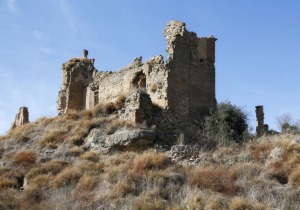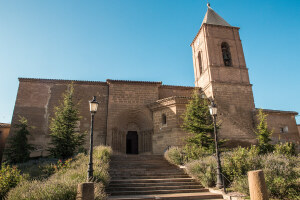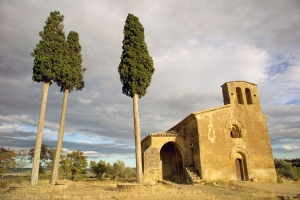The small town of Peraltilla lies alongside the N-240 road that unites Barbastro with Huesca. This is the starting point of a unique and surprising route, which takes in the ravine of La Clamor. Around Peraltilla you will first notice the huge blocks of gritty sandstone, surrounded by oak trees and cultivated fields. The remains of a 12th century medieval castle lay dormant on the top of the large rock, which gave name to the town (“petra alta” meaning “high stone.”) During the 9th century the castle was occupied by Muslim populations.
Following the A-1231, and just 700 metres from Peraltilla, it is possible to make out the legendary Stone of Santa Lucia to the right. It has a mysterious hollow in its centre, which is accessible by a small staircase dug from the rock.
Next on the agenda is the village of Azara. Here, in addition to a pleasant stroll around the quiet streets, a climb to the top of Santa Margarita's Rock is recommended. The remains of an old fortification are still in evidence, and a beautiful panorama of the town and its environs can be admired.
The route continues to climb up through the ravine of La Clamor and passes a strange succession of large rocks; aligned and leaning slightly, as if weary and needing support. Upon reaching the town ofAzlor, another great stone will call your attention. An old church bell tower sits above it, and the markings of the old castle still linger. The streets of Azlor are home to many houses with beautiful facades and a road leaving from near the cemetery leads to the Labanera Spring with its old washing area. This small circuit of just under a kilometre can be carried out by car if preferred. The starting point is found at the crossroads to the north of the town where an image of the Virgin of the Pilar presides.
Back to the main road, continue along in the direction of Abiego. Around 1.5 km from Azlor there is a road to the right that leads to the small Reservoir of the Moors, which collects the waters flowing from the ravine of La Clamor. A five-minute walk will take you from the metal fence of the road to this hidden and atmospheric place.
In the car once more, drive a further 500 meters down the main road until you arrive at the crossroads with the old Somontano cabañera (the old track for moving livestock.) Wandering to the left along a small dirt track you will come across the enigmatic Monument to the XX Century, a contemporary work of the sculptor, Ulrich Rückiem. In addition to the attraction of this amazing modern sculpture, this tranquil spot also boasts wonderful views over the peaks and plains of the Sierra of Guara and of the village of Abiego, which will be your next destination.
Abiego possesses many diverse elements of interest in its centre that are worthy of a visit. However, it has achieved a degree of fame due to a particularly special rock, which can be found on the outskirts of the town. This rock is the only place in the Somontano of Barbastro area, where the fossilized prints of mammals that walked the earth 25 million years ago can be found. To get there takes just 5 minutes. At the entrance of the town, just next a resting area with benches, take the road to the right signposted towards Adahuesca. From Abiego it is also possible to take a comfortable stroll to visit a medieval bridge on the River Alcanadre.
At just over 3 km from Abiego you will once again meet the cabañera. Follow it to the left for about 200 meters and a collection of stones around an iron cross will appear; this place is known locally asCrucelós. In this mysterious place, ancestral pagan rites have converged with Christian ways and history has merged with legend. In order to understand these old beliefs and rituals better, a visit to the Visitor Centre of Legends and Traditions in Adahuesca is highly recommended. The town, birthplace of the Saints Nunila and Alodia, also stands out for the rich heritage displayed in the secular and religious architecture. Many of the attractive houses display geometric symbols on their facades, their powerful significance faded with time.
Lovers of Romanesque art should not miss a visit to the chapel of Nuestra Señora de Treviñowhilst still in Adahuesca. It can be found on the same road as the village’s spring-fed well.
The town of Alberuela de Laliena, located 3 km from Adahuesca in the direction of Bierge, also has an interesting Romanesque church, which was named after San Nicolás of Bari.









